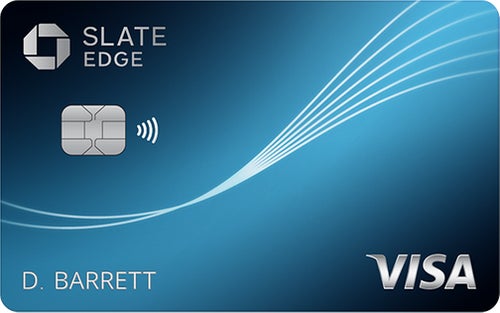Summary
While the Citi Simplicity card offers a longer interest-free promotional period, the Chase Slate card may save you more on a balance transfer – here’s why.
The content on this page is accurate as of the posting date; however, some of our partner offers may have expired. Please review our list of best credit cards, or use our CardMatch™ tool to find cards matched to your needs.
If you’re shopping for an interest-free credit card, your first instinct may be to look for a card with an extra-long promotional period. That way, you can save money on interest for several more months – or avoid paying interest altogether.
The Chase Slate Edge℠* and the Citi Simplicity® Card cards are worth considering if you plan on transferring a large balance. The right fit for you could depend on the total amount of your balance transfer, its respective balance transfer fee and how much time you need to pay off that debt.
The Citi Simplicity Card charges a balance transfer fee of $5 or 5% (whichever is greater), and the Slate Edge charges a $5 or 3% fee for balance transfers made within the first 60 days of account opening (after that, it’s the greater of $5 or 5%). However, the Slate Edge’s $100 cash bonus (if you spend $500 within the first six months) could offset that cost if your balance transfer fee is $100 or less, depending on your balance transfer amount.
For most new cardholders, the Chase Slate Edge card is the better option for transferring a large balance, given the total cost of the balance transfer and the smaller fee if you transfer within those first 60 days. However, the Citi Simplicity card is a good option if you need more time to pay down a large balance.
Still trying to decide between the two? Here’s what else to consider when comparing the two cards:
Chase Slate Edge vs. Citi Simplicity Card
 |  | |
| 0% intro balance transfer period | 12 months | 21 months (balance transfers must be completed within four months of account opening) |
| Balance transfer fee |
| $5 or 5% (whichever is greater) |
| 0% intro purchase period | 12 months | 12 months |
| Regular APR | 14.99%–23.74% (variable) | 14.99%–24.99% (variable) |
| Who should get this card? |
|
|
Earning rewards
If earning rewards is important to you, these cards may not be the right fit. The Chase Slate Edge and Citi Simplicity cards are dedicated balance transfer cards that don’t provide many card perks.
However, the Slate Edge offers access to Credit Journey (a digital tool to keep tabs on your credit score), My Chase Plan to manage your payment methods and guidance on how to earn a credit line increase. With the Slate Edge, you can be automatically considered for a higher limit if you spend $500 in the first six months while making timely payments.
Unlike other balance transfer cards, the Slate Edge sets itself apart from others in its category with a unique sign-up bonus offer. You can earn a $100 bonus on your statement if you spend $500 within the first six months of account opening. Plus, you can lower your APR by 2% each year if you pay on time and spend at least $1,000 using the card by your next account anniversary.
Meanwhile, the Citi Simplicity Card offers some benefits, such as the ability to complete contactless payments and choose your payment due date. You also have access to Citi Identity Theft Solutions to help recover stolen personal information. For the most part, however, it is a no-frills card.
Card fees
Similar to other balance transfer cards, the Chase Slate Edge and Citi Simplicity cards have a balance transfer fee. The Citi Simplicity Card charges a balance transfer fee of $5 or 5% (whichever is greater). The Slate Edge charges a $5 or 3% balance transfer fee during the first 60 days of account opening and afterward, a fee of $5 or 5% (whichever is greater) of the amount per transfer. If you have questions about what is required to make a balance transfer or are unsure how to complete one, check out these guides for Chase and Citi cardholders.
Neither card charges an annual fee or an over-the-limit fee. But it’s important to note that the Simplicity Card carries a limited fee schedule, making it more forgiving for those who may miss a payment.
With the Simplicity Card, you don’t have to worry about paying a late fee or penalty APR. On the other hand, the Slate Edge does charge a late fee of up to $40 and a penalty APR of up to 29.99% variable.
Penalty charges
| Chase Slate Edge | Citi Simplicity Card |
|
|
Best card for someone who wants to save on a balance transfer: Citi Simplicity Card
The Citi Simplicity Card offers a much longer balance transfer period than the Slate Edge card, giving cardholders 21 months to carry a balance at a 0% introductory APR, with a variable APR of 14.99% to 24.99% thereafter. It carries one of the longest balance transfer periods for 0% intro APR in the market, like the Wells Fargo Reflect℠Card. This card offers a zero-interest introductory period of up to 21 months from account opening on qualifying balance transfers (0% intro APR for 18 months from account opening on qualifying balance transfers with an extension of up to 3 months with on-time minimum payments during the intro and extension periods), followed by a regular variable APR of 13.24%-25.24% after.
The Chase Slate Edge, by contrast, gives cardholders just 12 months to pay off their balance before the card’s standard APR of 14.99% to 23.74% variable kicks in. Even if you earn the Chase Slate Edge’s $100 bonus after spending $500 in the first six months of account opening and need more than those 12 months, it won’t be enough to cover the interest charges for the extra months that are offered with the Simplicity Card.
By choosing the Simplicity card, you’d pay no interest for that extensive intro period, as long as you made all your payments on time.
Best card for someone who wants to finance a new purchase: It depends
Both the Citi Simplicity Card and the Chase Slate Edge card offer similar 0% introductory purchase APRs, offering an interest-free period of 12 months for new purchases. After the intro period ends, the Chase Slate Edge has a variable APR of 14.99% to 23.74%, whereas the Citi Simplicity card has a slightly higher variable APR of 14.99% to 24.99%.
However, the Slate Edge’s unique sign-up bonus of $100 (if you spend $500 within the first six months) could offset some of the cost of your purchase if you go past that intro period.
Which card makes the most sense for financing your large purchase will depend on how much you plan to spend and how much you can afford to pay off each month. It’s unfortunate that the Simplicity Card used to offer an extra six months to make payments against your balance, interest-free. Now both the Slate Edge and Simplicity cards offer 12 months yet, the Slate Edge offers the chance at a sign-up bonus that might cover some of your purchase financing.
We recommend using our payoff calculator to see how much you’ll pay in interest with the Slate Edge if it does take you more than 12 months to pay off the balance. If that number is less than $100, the Slate makes the most sense for you. But if it’s more than $100, you’re better off sticking to the longer introductory period on the Simplicity.
Best card for someone who’s at risk of forgetting a bill: Citi Simplicity
The Citi Simplicity Card is the better pick for cardholders who occasionally forget to pay their bills on time. Unlike the Chase Slate Edge, the Citi Simplicity Card doesn’t charge any late fees. If you slip up and pay your bill several days after it’s due, you won’t have to pay additional charges.
The Chase Slate Edge, by contrast, is less forgiving. There is a penalty APR and late fee involved with missed payments.
Bottom line
The Chase Slate Edge and the Citi Simplicity Card offer some of the best introductory APR promotions around. But despite their similarities, these are very different cards. The Citi Simplicity offers one of the longest balance transfer periods and has a limited slate of fees, making it more forgiving than other credit cards and worth considering if you miss a payment.
The Chase Slate Edge, by contrast, doesn’t offer as many months of carrying a balance. Still, the card’s sign-up bonus could help offset the cost of some interest on new purchases.
*All information about the Chase Slate Edge has been collected independently by CreditCards.com and has not been reviewed by the issuer.
Editorial Disclaimer
The editorial content on this page is based solely on the objective assessment of our writers and is not driven by advertising dollars. It has not been provided or commissioned by the credit card issuers. However, we may receive compensation when you click on links to products from our partners.





